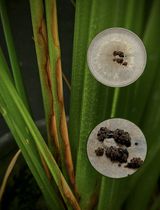- EN - English
- CN - 中文
Field Inoculation and Classification of Maize Ear Rot Caused by Fusarium verticillioides
田间接种和轮枝镰孢菌引起的玉米穗粒腐病的分类
(*contributed equally to this work) 发布: 2018年12月05日第8卷第23期 DOI: 10.21769/BioProtoc.3099 浏览次数: 7199
评审: Zhibing LaiWeixiao Yinjianrong Ye
Abstract
Maize ear rot is a worldwide fungal disease mainly caused by Fusarium verticillioides and Fusarium graminearum. Maize planted in the field was inoculated with Fusarium verticillioides at the filling stage, 15 days after pollination. Two milliliters of spore suspension with a concentration of 5 x 106/ml was injected into the middle of the top ear using pricking ear method to cause maize ear rot. The thirty days after inoculation was the most suitable time for phenotypic evaluation of Fusarium resistance.
Keywords: Maize (玉米)Background
Maize ear rot is a fungus-induced ear disease that occurs widely in Europe, America, Africa, Asia and Oceania (Desjardins et al., 2000; Pamphile and Azevedo, 2002; Hussain et al., 2005; Anjorin et al., 2008; Görtz et al., 2008; Rahjoo et al., 2008; Dorn et al., 2009; Eckard et al., 2011; Scauflaire et al., 2011; Madania et al., 2013). In 1977, maize ear rot swept through the state of Meghalaya, India. In 1988, maize ear rot was prevalent in the USA, and became a key biological control factor in maize production of African, resulting in a 48% reduction in maize yield (Vigier et al., 2001). Moreover, the infected maize ears also produced mycotoxins such as fumonisin and deoxynivalenol, which seriously threatened human and animals’ health (Gelderblom et al., 1988; Wild and Turner, 2002; Zhou et al., 2010).
At present, it is generally and internationally considered that Fusarium is the main pathogen causing ear rot in maize. However, different countries or different regions of the same country may have different types of pathogens, and the dominant pathogen may also be different in different regions. The dominant pathogen is Fusarium graminearum in the USA, Austria and Germany (Schaafsma et al., 1997; Goertz et al., 2010; Mesterházy et al., 2012), but Fusarium verticillioides in France, South Africa, Croatia, Iran, Argentina, Brazil and China (Presello et al., 2004; Aliakbari et al., 2007; Ivić et al., 2008; Folcher et al., 2010; Small et al., 2012; Stumpf et al., 2013; Qin et al., 2014). No matter what the pathogen is, it is very important to have an effective artificial inoculating method in order to get the accuracy resistance evaluation.
To date, a total of four inoculation methods were reported in publications, silk channel injection method, silk spray method, prick ear method and toothpick method. A large number of maize germplasms with resistance to maize ear rot were screened by prick ear method and the genetic basis of the resistance were elucidated in our previous study (Chen et al., 2002; Dong et al., 2006; Li et al., 2008; Sun, 2009; Chen, 2012; Li, 2012; Wang et al., 2016). This method that can easily control the inoculation dose together with the suitable inoculation time can accurately reflect the underlying resistance in the maize materials.
Materials and Reagents
- Gauze
- Mask
- Adhesive tape of paper
- Newspaper
- Inoculating needle
- Elastic
- Petri dish, 90 x 90 mm (Biosharp, catalog number: BS-90-D)
- Latex gloves (Biosharp, catalog number: BS-ST-001)
- Parafilm, 100 mm x 38 m (Parafilm, catalog number: PM-996)
- Aseptic breathable seal membrane
- Cover glass
- Scalpel
- Newly harvested maize hybrid seeds (Used for the growth of Fusarium verticillioides, Procedure B)
- Potato
- Fusarium verticillioides (The fungus strain was stored with glycerol in -80 °C refrigerator)
- Tween-80 (Solarbio, catalog number: P8360)
- Alcohol
- Sterile water
- D-glucose (Solarbio, catalog number: G8150)
- Agar powder (Solarbio, catalog number: A8190)
- PDA medium (see Recipes)
Equipment
- Glass rod
- 10 μl pipette (Eppendorf, 0.5-10 μl)
- Alcohol lamp filled with alcohol
- 2,000 ml beaker
- 500 ml conical flask
- 500 ml-1,000 ml water bottle
- Plastic bucket
- Super clean bench (HDL, model: HD-1360)
- Light incubator (Haixiang, model: PGX-400BP)
- High-pressure sterilizer (Boxun, model: YXQ-LS-52SII)
- Veterinary adjustable continuous syringe (Jiashan, model: 2ml-K, catalog number: JS-003, URL: http://www.jiashanqx.com/cn/products.asp?Bid=51)
- Light microscope (Motic, model: BA310)
- Hemacytometer (0.1 mm, 1/400 mm2, 16 x 25) (Qiujing, model: XB-K-25)
- Refrigerator (Haier, model: BCD-215KS)
Procedure
文章信息
版权信息
© 2018 The Authors; exclusive licensee Bio-protocol LLC.
如何引用
Dong, C., Wu, Y., Gao, J., Zhou, Z., Mu, C., Ma, P., Chen, J. and Wu, J. (2018). Field Inoculation and Classification of Maize Ear Rot Caused by Fusarium verticillioides. Bio-protocol 8(23): e3099. DOI: 10.21769/BioProtoc.3099.
分类
微生物学 > 微生物-宿主相互作用 > 真菌
您对这篇实验方法有问题吗?
在此处发布您的问题,我们将邀请本文作者来回答。同时,我们会将您的问题发布到Bio-protocol Exchange,以便寻求社区成员的帮助。
Share
Bluesky
X
Copy link
















